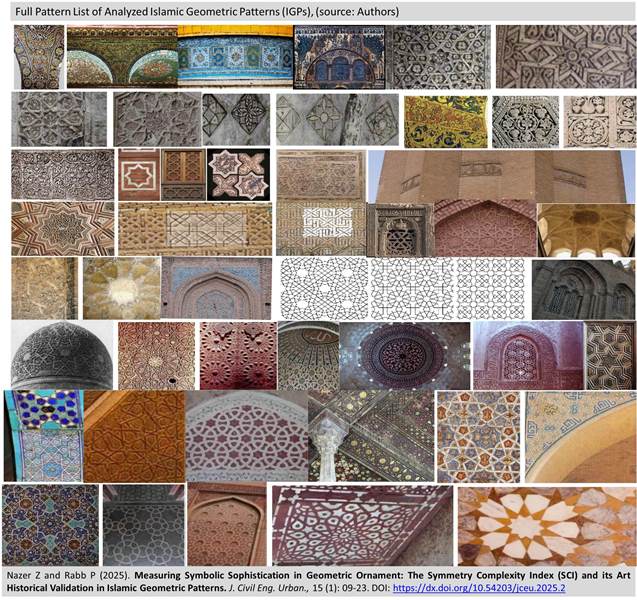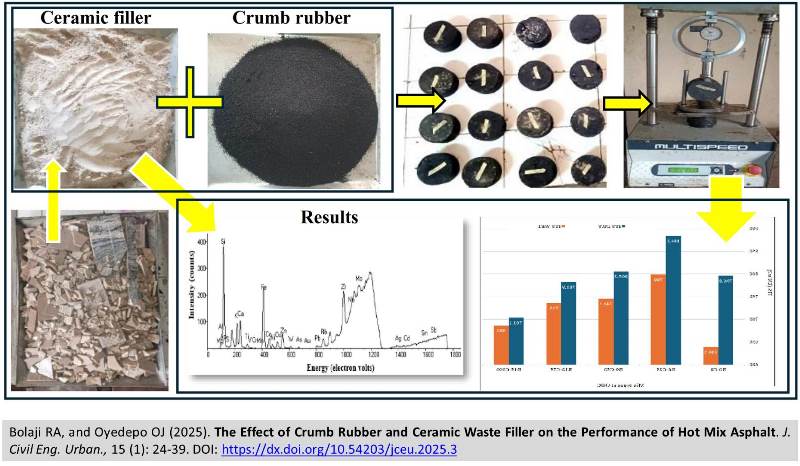Most read content
Partner Journal
<Previous issue | Next issue> | Archive
Volume 15 (1); January, 2025
|
|
Research Paper
Comparative Assessment of Heavy Metals in Well and Borehole Water in Akure, Ondo State, Nigeria
Ojo OM, Obiora-Okeke OA and Adeniran DO.
J. Civil Eng. Urban., 15(1): 1-8, 2025; pii:S225204302500001-15
DOI: https://dx.doi.org/10.54203/jceu.2025.1
Abstract
Groundwater sources such as wells and boreholes serve as primary drinking water supplies in many communities especially in developing countries like Nigeria. However, the presence of heavy metals in these sources poses potential health risks. This study evaluates and compares the concentrations of iron (Fe), chromium (Cr), cadmium (Cd), and manganese (Mn) in well and borehole water samples collected from five locations each in Shagari Village, Akure, Ondo State, Nigeria. Water samples were analyzed in the laboratory to determine their heavy metal concentrations. Results showed that Fe levels are higher in well water (0.134–0.163 ppm) compared to borehole water (0.078–0.110 ppm). Chromium concentrations are higher (0.063–0.080 ppm) in borehole water than in well water (0.023–0.030 ppm), with some borehole samples exceeding the WHO limit of 0.05 ppm. Cadmium levels varied slightly, with well water ranging from 0.004–0.009 ppm and borehole water from 0.006–0.010 ppm. Manganese concentrations were similar in both sources, with slight variations. The findings suggest that well water may have higher Fe concentrations due to soil leaching, while borehole water exhibits higher Cr levels, possibly due to geological formations. Continuous monitoring and appropriate treatment methods are recommended to ensure water safety.
Keywords: Heavy metals, groundwater, well, borehole, quality, Shagari Village, Akure
[Full text-PDF] [Crossref Metadata] [Export from ePrints]
|
|
Research Paper
Measuring Symbolic Sophistication in Geometric Ornament: The Symmetry Complexity Index and its Art Historical Validation in Islamic Geometric Patterns
Nazer Z and Rabb P.
J. Civil Eng. Urban., 15(1): 9-23, 2025; pii:S225204302500002-15
 DOI: https://dx.doi.org/10.54203/jceu.2025.2
DOI: https://dx.doi.org/10.54203/jceu.2025.2
Abstract
This study introduces the Symmetry Complexity Index (SCI), a computational metric to quantify the symbolic sophistication of Islamic geometric patterns (IGPs). Grounded in group theory, the SCI assesses symmetry complexity through weighted operations, hypothesizing that higher scores reflect greater symbolic depth. We analyzed 41 IGPs from key Islamic dynasties (Umayyad to Mughal, 660–1737 CE) and validated the SCI through expert consultation (n = 5, r = 0.87, p < 0.001). The results revealed a clear evolutionary trend, with SCI scores rising from basic 6-point patterns (SCI = 40–50) in the Abbasid era to complex 16-point patterns (SCI = 70–85) during the Mamluk period, alongside notable regional variations, such as Mughal simplicity and Mamluk intricacy. The findings of this study highlight the SCI’s effectiveness in capturing historical developments in symbolic sophistication. This study recommends the broader application of the SCI for analyzing geometric ornamentation and exploring the relationship between decorative complexity and urban identity in Islamic architecture.
Keywords: Symmetry Complexity Index, Islamic Geometric Patterns, Computational Art History, Symmetry Analysis, Symbolic Meaning, Islamic Architecture.
[Full text-PDF] [Crossref Metadata] [Export from ePrints]
|
|
Research Paper
The Effect of Crumb Rubber and Ceramic Waste Filler on the Performance of Hot Mix Asphalt
Bolaji RA, and Oyedepo OJ.
J. Civil Eng. Urban., 15(1): 24-39, 2025; pii:S225204302500003-15
 DOI: https://dx.doi.org/10.54203/jceu.2025.3
DOI: https://dx.doi.org/10.54203/jceu.2025.3
Abstract
In curtailing the effects of scrap tires and ceramic waste in the environment, this study evaluates the effect of crumb rubber as bitumen modifier and ceramic waste as filler on the performance of hot mix asphalt. Bitumen was modified with crumb rubber in increasing percentages of 0%, 6%, 9%, 12% and 15%, by the weight of bitumen, while limestone filler was replaced with ceramic filler at 0%, 25%, 50%, 75%, and 100% proportions by the weight of total filler. Five asphalt mix types were produced and evaluated, based on Marshall mix design method for heavy traffic. The physical and chemical characterization of crumb rubber and ceramic filler showed that their properties were within the specified range and could be potentially applied in hot mix asphalt. In comparison to other variations, the modified mix which contained 6% crumb rubber and 25% replacement of limestone filler with ceramic filler, gave better resistance to deformation and rutting, cracking and moisture susceptibility, from the obtained Marshall flow of 2.92 mm, stability of 32.57 KN, Marshall quotient of 11.15 KN/mm, indirect tensile strength (dry) of 884.2 KN and tensile strength ratio of 90.36 % KN/m2. The combination of 6% crumb rubber and 25% ceramic filler effectively enhanced the performance of hot mix asphalt, thereby offering as a sustainable approach for recycling these waste materials.
Keywords: Crumb rubber, Ceramic filler, Hot mix asphalt, Marshall properties, Indirect tensile strength, Waste
[Full text-PDF] [Crossref Metadata] [Export from ePrints]
<Previous issue | Next issue> | Archive
This work is licensed under a Creative Commons Attribution 4.0 International License (CC BY 4.0)![]()




